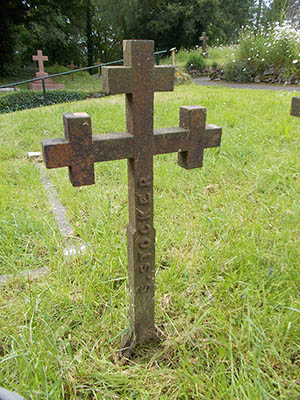

On a sombre note, whether it’s a headstone, a gravestone, a tombstone, a memorial or just a simple marker; when it comes to marking a burial site in a traditional churchyard or cemetery these ways of indicating the place of burial can vary from a large ornate memorial, to an engraved headstone, often of granite, sometimes slate or marble. Each of these words has its own meaning. A tombstone originally referred to the stone lid of a stone coffin whereas gravestone refers to the stone slab placed over a grave. One material that can occasionally be seen in churchyards marking a grave is cast iron. It has to be said that cast iron is considerably cheaper than stone but there are instances when iron has been cast into quite large and ornate examples that in cost must equal that of stone. Around 1860 – 1870, with the decline in demand for some more commonplace cast iron products, some foundries turned to grave markers as a useful source of income. Often the designs available were promoted in catalogues which were prolific at the time and sometimes marketed directly to Clergy and Parishes, particularly those in the country.
In Garton & King’s archive material is this small drawing of three designs of crosses in cast iron. This is from the short era of King & Munk (See Chapter Six of our History) which existed in the late 1860s. It is probable that the output of these by the Company was small in number. Unfortunately it is hard to identify those made by the Company as often the iron founder’s name is cast into the buried part of the memorial, though some foundries cast their name on the back of what remains above ground. One fairly common name appearing in this manner are those cast by Haden of Warminster. Examples of these have been found at St Barnabas Churchyard at Brooking, near Dartington in Devon.
Iron crosses were often used to mark young persons’ burials as the death rate in Victorian times of children before they even reached their teens was significantly higher than nowadays; as the following example shows:-
John Stocker was approximately 42 in 1861. He lived at the Old Parsonage in Huntsham near Tiverton and his occupation was a stone mason. He was married to Esther, then aged 35 and had six children, William, Susan, Mary, Joseph, John, and Walter. Unfortunately his wife died in 1865, William in 1866, Mary in 1866 and Susan in 1868. John’s movements after 1861 are somewhat vague as the deaths of Esther and William occurred outside of the U.K. though John is recorded again at the Old Parsonage in 1871 but by then he had remarried and his second wife, Sara had by then given birth to three children.
In one of Garton & King’s Order books on the page dated 26th September 1866, under the entry for Troyte, Huntsham Court, is the following entry:-
STOCKER, Mr. Huntsham, by rail to Tiverton Road. 3 Cast Iron Grave Crosses. Letter(e)d to order including time to pattern &c Guest (?)…………………… £.1 – 1 – 0d
Susan Stocker did not die until 1868 so the three Crosses must have been for Esther his wife, son William and daughter Mary. The fourth cross was presumably added in about 1868 when Susan died. The Stone Monument is for the head of the family, John Stocker. The order from Right to Left in the image therefore is Esther, John’s first wife (aged 39), John’s stone memorial , he died in 1885 aged about 68. Mary Stocker (aged 14), William Stocker ( aged 20) and Susan Stocker (aged 19). Ages are approximate.
The back of each Iron Cross gives the identity of the person by means of the initial of their Christian Name and their Surname.
ESTHER STOCKER |
MARY STOCKER |
|
WILLIAM STOCKER |
SUSAN STOCKER |
Ironically there are crosses in Iron, though somewhat more ornate, for the members of the Troyte Acland Family on the other side of the footpath leading to the entrance of the Church! – I doubt if they were made by Garton & King – as they should be left undisturbed I’m unlikely ever to find out.
An additional source of income for the Company, relating to Cemeteries in general was the provision of Tomb Railings – the family providing such protection to a gravesite or memorial would need to pay out quite a significant sum for this protection and embellishment.
This image shows a drawing and details of work involved from John Garton Junior’s September 1848 Order and Price Book for the Tomb Railing surrounding the R Cornish Esq. Tomb in Alphington (Exeter) Churchyard – two points of regret, the price of the work is in code and the railings have disappeared and were most probably cut down in the Drive For Scrap in the Second World War.
If YOU have any information or Archive material relating to Garton & King that you can share, please contact me – or post a comment here on the site in the Guestbook.
June 2019
Top of Page
See also:
Monuments — Railings — Iron Gates
Mixed Bag — Oddities — Little Bit Unusual
Sitemap / Contents